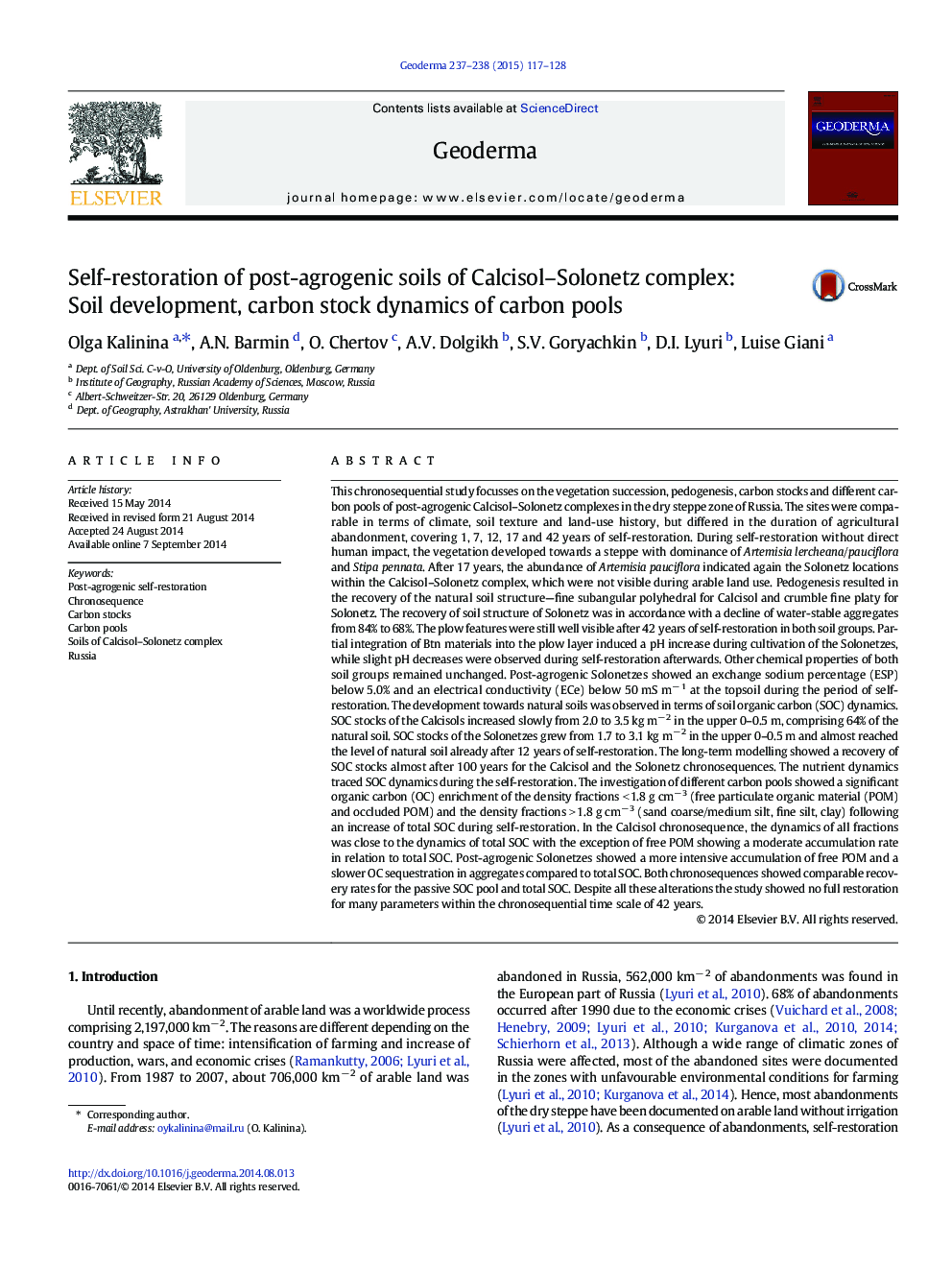| کد مقاله | کد نشریه | سال انتشار | مقاله انگلیسی | نسخه تمام متن |
|---|---|---|---|---|
| 4573276 | 1629467 | 2015 | 12 صفحه PDF | دانلود رایگان |
• Self-restoration of post-agrogenic Calcisols and Solonetzes was studied with chronosequential approach.
• Spatial relationship between plant species and soil variables occurred after 17 years of self-restoration.
• Soil structure, aggregation, and SOC developed towards their natural characteristics.
• OC of active and passive pools reflected an increase of total SOC.
• No full restoration took place within the time of 42 years.
This chronosequential study focusses on the vegetation succession, pedogenesis, carbon stocks and different carbon pools of post-agrogenic Calcisol–Solonetz complexes in the dry steppe zone of Russia. The sites were comparable in terms of climate, soil texture and land-use history, but differed in the duration of agricultural abandonment, covering 1, 7, 12, 17 and 42 years of self-restoration. During self-restoration without direct human impact, the vegetation developed towards a steppe with dominance of Artemisia lercheana/pauciflora and Stipa pennata. After 17 years, the abundance of Artemisia pauciflora indicated again the Solonetz locations within the Calcisol–Solonetz complex, which were not visible during arable land use. Pedogenesis resulted in the recovery of the natural soil structure—fine subangular polyhedral for Calcisol and crumble fine platy for Solonetz. The recovery of soil structure of Solonetz was in accordance with a decline of water-stable aggregates from 84% to 68%. The plow features were still well visible after 42 years of self-restoration in both soil groups. Partial integration of Btn materials into the plow layer induced a pH increase during cultivation of the Solonetzes, while slight pH decreases were observed during self-restoration afterwards. Other chemical properties of both soil groups remained unchanged. Post-agrogenic Solonetzes showed an exchange sodium percentage (ESP) below 5.0% and an electrical conductivity (ECe) below 50 mS m− 1 at the topsoil during the period of self-restoration. The development towards natural soils was observed in terms of soil organic carbon (SOC) dynamics. SOC stocks of the Calcisols increased slowly from 2.0 to 3.5 kg m− 2 in the upper 0–0.5 m, comprising 64% of the natural soil. SOC stocks of the Solonetzes grew from 1.7 to 3.1 kg m− 2 in the upper 0–0.5 m and almost reached the level of natural soil already after 12 years of self-restoration. The long-term modelling showed a recovery of SOC stocks almost after 100 years for the Calcisol and the Solonetz chronosequences. The nutrient dynamics traced SOC dynamics during the self-restoration. The investigation of different carbon pools showed a significant organic carbon (OC) enrichment of the density fractions < 1.8 g cm− 3 (free particulate organic material (POM) and occluded POM) and the density fractions > 1.8 g cm− 3 (sand coarse/medium silt, fine silt, clay) following an increase of total SOC during self-restoration. In the Calcisol chronosequence, the dynamics of all fractions was close to the dynamics of total SOC with the exception of free POM showing a moderate accumulation rate in relation to total SOC. Post-agrogenic Solonetzes showed a more intensive accumulation of free POM and a slower OC sequestration in aggregates compared to total SOC. Both chronosequences showed comparable recovery rates for the passive SOC pool and total SOC. Despite all these alterations the study showed no full restoration for many parameters within the chronosequential time scale of 42 years.
Journal: Geoderma - Volumes 237–238, January 2015, Pages 117–128
